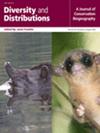Environmental DNA Metabarcoding Elucidates Freshwater Mussel Diversity and Occupancy to Facilitate Improved Management and Conservation
Abstract
Aim
Freshwater mussels are considered among the most at-risk taxa in the world. As such, comprehensive monitoring assessments of what abiotic and biotic factors influence mussel occupancy will be vital for guiding effective conservation. Here, we analysed vertebrate and mussel environmental DNA (eDNA) metabarcoding data to explore the influence of biotic (i.e., host fish diversity, predator presence, and community composition) and abiotic (i.e., drainage size, forest cover, and stream order) factors on freshwater mussel populations.
Location
This study utilised water samples and tactile survey data collected from streams throughout Fort Johnson, Louisiana.
Methods
We first evaluated the effectiveness of eDNA metabarcoding for characterising freshwater communities based on previous conventional tactile surveys. Next, we used eDNA metabarcoding analysis for freshwater mussels and vertebrate species alongside GIS-derived satellite remote sensing data to assess how various biotic and abiotic variables impact freshwater mussel eDNA occupancy.
Results
Our eDNA metabarcoding survey largely agreed with both historical and contemporary surveys on Fort Johnson, while uniquely detecting Louisiana pigtoe (Pleurobema riddellii), a proposed threatened species under the US Endangered Species Act. We also found that eDNA detections and occupancy had strong seasonal variation, with increased read abundance and diversity in the spring. Vertebrate, fish, and predator diversity (as a function of habitat quality) were strongly predictive of mussel occupancy, supporting the concept of land managers focusing on the entire ecosystem for mussel conservation. Lastly, we found that percent forest cover and drainage basin size influenced mussel eDNA occupancy, informing habitat associations for mussel species of interest (i.e., the mussels occupied larger drainage sizes and perennial streams).
Conclusions
Our results demonstrate that combining eDNA metabarcoding of target and non-target species with occupancy modelling can provide insights into the ecology of freshwater mussels and is a useful tool to improve their conservation and management.


 求助内容:
求助内容: 应助结果提醒方式:
应助结果提醒方式:


